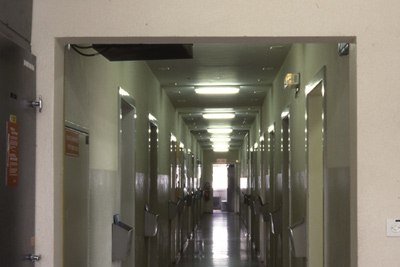![]()
![]()
![]()
![]()
...
...
.....
...
...
...
...
CERN
Flusser
Lord's Bridge
Lightning Field
CERN, office corridor, 2000
[Photograph | Tim O'Riley]
Between late-1999 and 2001, I was involved in a commissioned collaboration with scientists at CERN, Geneva, the world's largest particle physics laboratory.* My involvement stemmed from an ongoing preoccupation with the relation between physical reality and virtual/pictorial space, research centring around the seeming paradoxes and uncertainties associated with quantum mechanics. Over two years, artworks were made using CG modelling processes in response to field trips, discussions and independent research. Rather than focus on specific methods or apparatuses, my work generated associative responses to some of the conceptual and philosophical implications of the science taking place at CERN.
My first visits in 1999-2000 had coincided with the decommissioning of the LEP or Large Electron–Positron Collider which had been running for 11 years. The same response persisted throughout these visits. I remained intrigued by the place and the people I met but also encountered a pervading feeling of placeless-ness. What was I doing there? I had no mathematical understanding of the science being explored and the invisibility - at a human scale - of the things being observed seemed in contradiction to the enormity of the place and the experimental equipment.
I was struck by the signs of human presence in the anonymity and impenetrability of the place. Wandering about the warren-like spaces that house the sophisticated machines used for the experiments, I would sometimes come across a piece of furniture abandoned in a forgotten corner or a makeshift work space in the most unexpected of places - an old table and chair with a pullover draped over it, for example. But it always seemed empty, as if everyone had mysteriously vanished. Confronted with the apparent impenetrability of the whole enterprise that constitutes particle physics, these small fragments or signs of human presence began to take on a special quality. Traces of things no longer present, they reminded me of the images of the trajectories of countless minuscule particles as they collided in one or other of the experiments.
(*The project was
co-funded by the Particle Physics and Astronomy Research Council, the
British Council, CERN and The London Institute. The exhibition toured
from London to galleries/museums in Rome, Geneva, Lisbon and New York.)
![]()
![]()
![]()
